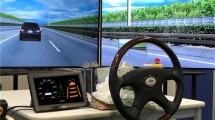Abstract
In Level 3 (L3) autonomous driving, the system issues a take-over request to the driver if the Automated Driving System (ADS) fails or operates outside its design domain. The driver must takeover control and resume vehicle operation. This study demonstrates that in Level 3 (L3) autonomous vehicles, varied information presentation strategies—namely no explanation, reason explanation (Why), outcome explanation (What), and both reason and outcome explanation (What + Why)—significantly affect drivers’ situational awareness and take-over performance. The “What + Why” strategy yields the most significant improvements. Furthermore, the research highlights differences in the effectiveness of these strategies among less experienced drivers and a gender disparity in responses to the “Why” explanation, with males showing more favorable outcomes. In conclusion, effective information presentation is crucial in autonomous vehicle human-machine interfaces, particularly for L3 systems. This underscores the need for user-centered, interpretable AI that customizes information delivery according to driver-specific characteristics, optimizing performance and safety.
Access this chapter
Tax calculation will be finalised at checkout
Purchases are for personal use only
Similar content being viewed by others
References
Badue, C., et al.: Self-driving cars: a survey. Expert Syst. Appl. 165, 113816 (2021)
Lai, J., et al.: A generic simulation platform for cooperative adaptive cruise control under partially connected and automated environment. Transport. Res. Part C: Emerg. Technol. 121, 102874 (2020)
Hu, J., Zhang, Z.H., Xiong, L., et al.: Cut through traffic to catch green light: eco approach with overtaking capability. Transport. Res. Part C: Emerg. Technol. 123, 102927 (2021)
Bonnefon, J.F., Shariff, A., Rahwan, I.: The social dilemma of autonomous vehicles. Science 352, 1573 (2016)
SAE J 3016–2014, Taxonomy and definitions for terms related to on-road motor vehicle automated driving systems (2014)
SAE International. Taxonomy and definitions for terms related to driving automation systems for on-road motor vehicles. SAE International, New York (2021)
Atakishiyev, S., Salameh, M., Yao, H., Goebel, R.: Explainable artificial intelligence for autonomous driving: a comprehensive overview and field guide for future research directions (2021). arXiv pre-print arXiv:2112.11561
Koo, J., Kwac, J., Ju, W., Steinert, M., Leifer, L., Nass, C.: Why did my car just do that? explaining semi-autonomous driving actions to improve driver understanding, trust, and performance. Int. J. Interact. Des. Manuf. 9(4), 269–275 (2015). https://doi.org/10.1007/s12008-014-0227-2
Rezvani, T., Driggs-Campbell, K., Bajcsy, R.: Optimizing interaction between humans and autonomy via information con-straints on interface design [Paper presentation]. In: 2017 IEEE 20th International Conference on Intelligent Transportation Systems (ITSC), pp. 1–6. IEEE (2017). https://doi.org/10.1109/itsc.2017.8317686
SAE International. Taxonomy and Definitions for Terms Related to Driving Automation Systems for On-Road Motor Vehicles (2021). https://doi.org/10.4271/J3016_202104
Techer, F., et al.: Anger and highly automated driving in urban areas: The role of time pressure. Transport. Res. Part F: Traffic Psychol. Behav. 64, 353–360 (2019)
Xing, Y., et al.: Toward human-vehicle collaboration: review and perspectives on human-centered collaborative automated driving. Transport. Res. Part C: Emerg. Technol. 128, 103199 (2021)
Zhang, W., et al.: Optimal time intervals in two-stage takeover warning systems with insight into the drivers’ neuroticism personality. Front. Psychol. 12, 601536 (2021)
Zhang, B., et al.: Determinants of take-over time from automated driving: a meta-analysis of 129 studies. Transport. Res. Part F: Traffic Psychol. Behav. 64, 285–307 (2019)
Ma, S., et al.: Take over gradually in conditional automated driving: the effect of two-stage warning systems on situation awareness, driving stress, takeover performance, and acceptance. Int. J. Hum.-Comput. Interact. 37(4), 352–362 (2021)
Qu, J., et al.: Understanding trust calibration in automated driving: the effect of time, personality, and system warning design. Ergonomics 1–17 (2023)
Bazilinskyy, P., Petermeijer, S.M., Petrovych, V., et al.: Take-over requests in highly automated driving: a crowdsourcing survey on auditory, vibrotactile, and visual displays. Transport. Res. F: Traffic Psychol. Behav. 56, 82–98 (2018)
Chen, S., Leng, Y., Labi, S.: A deep learning algorithm for simulating autonomous driving considering prior knowledge and temporal information. Comput.-Aided Civil Infrastruct. Eng. 35(4), 305–321 (2020)
Di, X., Shi, R.: A survey on autonomous vehicle control in the era of mixed-autonomy: from physics-based to AI-guided driving policy learning. Transport. Res. Part C: Emerg. Technol. 125, 103008 (2021)
Dong, J., et al.: Space-weighted information fusion using deep reinforcement learning: the context of tactical control of lane-changing autonomous vehicles and connectivity range assessment. Transport. Res. Part C: Emerg. Technol. 128, 103192 (2021)
Hulse, L.M., Xie, H., Galea, E.R.: Perceptions of autonomous vehicles: relationships with road users, risk, gender and age. Saf. Sci. 102, 1–13 (2018)
Omeiza, D., et al.: Explanations in autonomous driving: a survey. IEEE Trans. Intell. Transport. Syst. 23(8), 10142–10162 (2021)
Atakishiyev, S., et al.: Explainable artificial intelligence for autonomous driving: a comprehensive overview and field guide for future research directions. arXiv preprint arXiv:2112.11561 (2021)
Koo, J., et al.: Why did my car just do that? explaining semi-autonomous driving actions to improve driver understanding, trust, and performance. Int. J. Interact. Des. Manuf. (IJIDeM) 9, 269–275 (2015)
Rezvani, T., Driggs-Campbell, K., Bajcsy, R.: Optimizing interaction between humans and autonomy via information constraints on interface design. In: 2017 IEEE 20th International Conference on Intelligent Transportation Systems (ITSC). IEEE (2017)
Yan, F., et al.: Spatial visualization of sensor information for automated vehicles. In: Proceedings of the 11th International Conference on Automotive User Interfaces and Interactive Vehicular Applications: Adjunct Proceedings (2019)
Wang, M.J., et al.: Using advisory 3D sound cues to improve drivers’ performance and situation awareness. In: Proceedings of the 2017 CHI Conference on Human Factors in Computing Systems (2017)
Endsley, M.R.: Situation awareness in future autonomous vehicles: beware of the unexpected. In: Bagnara, S., Tartaglia, R., Albolino, S., Alexander, T., Fujita, Y. (eds.) IEA 2018. AISC, vol. 824, pp. 303–309. Springer, Cham (2019). https://doi.org/10.1007/978-3-319-96071-5_32
Sirkin, D., et al.: Toward measurement of situation awareness in autonomous vehicles. In: Proceedings of the 2017 CHI Conference on Human Factors in Computing Systems (2017)
Banks, V.A., Plant, K.L., Stanton, N.A.: Driver error or designer error: using the perceptual cycle Model to explore the circumstances surrounding the fatal Tesla crash on 7th May 2016. Saf. Sci. 108, 278–285 (2018)
Muir, B.M.: Trust between humans and machines, and the design of decision aids. Int. J. Man Mach. Stud. 27(5–6), 527–539 (1987)
Du, N., et al.: Look who’s talking now: Implications of AV’s explanations on driver’s trust, AV preference, anxiety and mental workload. Transpor. Res. Part C: Emerg. Technol. 104, 428–442 (2019)
Frison, A.-K., et al.: Why do you like to drive automated? a context-dependent analysis of highly automated driving to elaborate requirements for intelligent user interfaces. In: Proceedings of the 24th International Conference on Intelligent User Interfaces (2019)
Holthausen, B.E., et al.: Situational trust scale for automated driving (STS-AD): development and initial validation. In: 12th International Conference on Automotive User Interfaces and Interactive Vehicular Applications (2020)
Abraham, H., et al.: Autonomous vehicles and alternatives to driving: trust, preferences, and effects of age. In: Proceedings of the Transportation Research Board 96th Annual Meeting. Transportation Research Board, Washington, DC (2017)
Koo, J., et al.: Understanding driver responses to voice alerts of autonomous car operations. Int. J. Veh. Des. 70(4), 377–392 (2016)
Shabanpour, R., et al.: Eliciting preferences for adoption of fully automated vehicles using best-worst analysis. Transport. Res. Part C: Emerg. Technol. 93, 463–478 (2018)
Taylor, R.M.: Situational awareness rating technique (SART): The development of a tool for aircrew systems design. Situational Awareness in Aerospace Operations (AGARD-CP-478). Neuilly Sur Seine, France: NATO-AGARD (1990)
Cooper, D.: Effective safety leadership: Understanding types & styles that improve safety performance. Prof. Saf. 60(02), 49–53 (2015)
Acknowledgments
This study was supported by the Natural Science Foundation of Hunan Province of China (No. 2023JJ30149).
Author information
Authors and Affiliations
Corresponding author
Editor information
Editors and Affiliations
Rights and permissions
Copyright information
© 2024 The Author(s), under exclusive license to Springer Nature Switzerland AG
About this paper
Cite this paper
Fu, X., Zou, Y., Tan, H. (2024). Exploring the Impact of Interpretable Information Types on Driver's Situational Awareness and Performance During Driving Take-Over. In: Rau, PL.P. (eds) Cross-Cultural Design. HCII 2024. Lecture Notes in Computer Science, vol 14702. Springer, Cham. https://doi.org/10.1007/978-3-031-60913-8_8
Download citation
DOI: https://doi.org/10.1007/978-3-031-60913-8_8
Published:
Publisher Name: Springer, Cham
Print ISBN: 978-3-031-60912-1
Online ISBN: 978-3-031-60913-8
eBook Packages: Computer ScienceComputer Science (R0)




